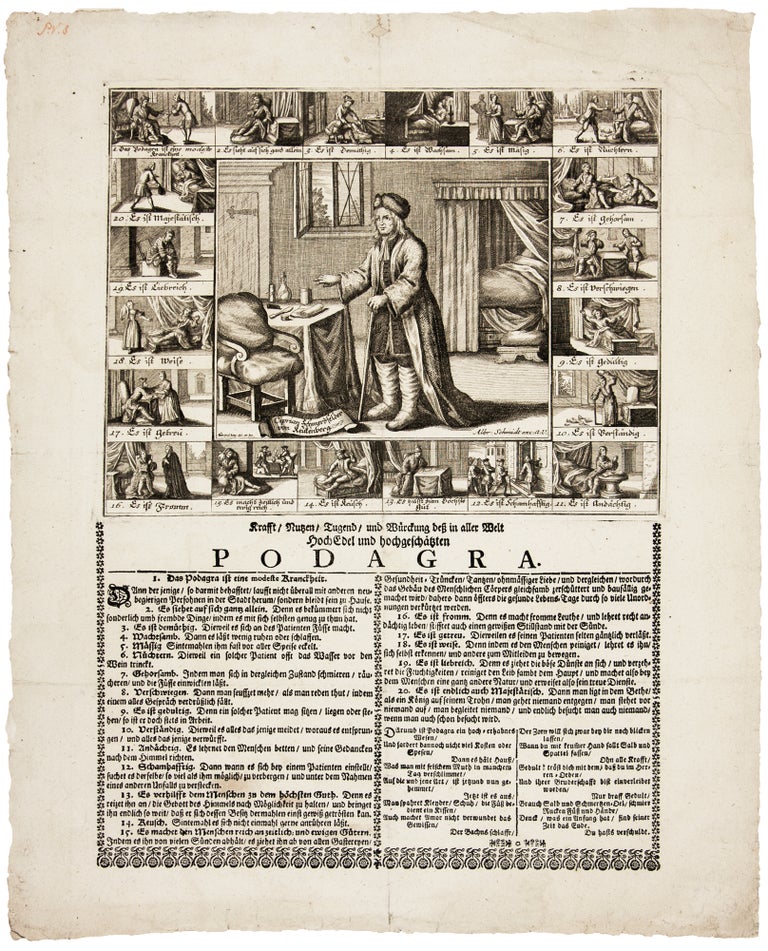
Krafft, Nutzen,Tugend und Würckung deß in aller Welt Hoch Edel und hochgeschätzten Podagra.
Sheet size: ca. 42.5 x 37.5 cm; Engraving: ca. 20 x 25.5 cm. A central copper engraved image within a border of 20 small, engraved images (numbered 1-20), depicting the "virtues" of gout, engraved by Gottfried Rogg. Underneath the engraving is the title of the print and an explanatory text of the small images, followed by a poem on Podagra, all printed within a three-sided woodcut border, separated in two columns. Excellent. A very rare separately published illustrated broadside on the disease of podagra or gout, a form of arthritis, by Gottfried Rogg (1669-1742), a draughtsman, engraver, and publisher in Augsburg. The central image depicts a well-dressed nobleman with legs wrapped in special gout stockings in front of a table covered with ointment jars, spatula, and bandages. His name, printed in a scroll at his feet--Ciprian Schmerzfelder von Keukenberg, is a word play on "Schmerz" (pain) and Keuch ("gasp or wheeze"). The twenty small illustrations surrounding the central image render the broadside an appearance of a modern comic strip. They depict and list the amusing "virtues" of gout, which are further elaborated in the text below the central image. To quote just a few: "the podagra is a fashionable ailment, because he who is burdened by it does not run around all over town with other ambitious persons, but remains elegantly at home"; "it restrains him from many sins, it deters him from all feasts, toasts, dances, immoderate lovemaking, and so forth, whereby the structure of the human body becomes virtually shattered and decrepit, wherefore the healthy days of life are then frequently shortened by a great many disorders"; etc. (See Benedek and Rodnan for the full translation of the print into the English). It was believed that gout was caused by overindulgence in food and drinking. Since the latter could only be afforded by the rich, the disease was often seen as a mark of nobility. At the same time, gout was understood as a protection against other illnesses due to the idea of mutual exclusivity of diseases. As such, it was sometimes seen as insurance against worse illnesses, including syphilis. The author of the print clearly holds overindulgence accountable for the disease, yet offers some consolation to its victims: Patience! In this nobility take consolation, And the fellowship into which you have gained initiation. Remain but patient! Use salve and analgesic oil, grease back, hands and feet; Consider: what has a beginning in due time its end will meet. You are to blame. Gout encomiums were a popular genre in European literature with earliest examples dating back to the ancient Greek poet Lucian. Revitalized by Petrarch, podagra eulogy peaked in Germany during the sixteenth and seventeenth century in humanist writing (especially by Erasmus, Sebastian Brant, Willibald Pirckheimer, Johann Fischart and Jakob Baldes). However, few such writings were primarily pictorial, which makes this unusually elaborate broadside to stand out among gout-related literature. We could locate only one copy of the print worldwide--at Frankfurt University. *Benedek and Rodnan, "Podagra by Gottfried Rogg: An illustrated encomium on the gout," in Journal of the History of Medicine and Allied Sciences 18/4 (Oct. 1963), pp. 349-352; Thieme/ Becker, vol. 28, pp. 516-517; Porter, Rousseau, Gout: The Patrician Malady, pp. 34-35; Scholtens, "The glorification of gout in 16th- to 18th-century literature," CMAJ (October 07, 2008) 179/8, pp. 804-805.
Price: $3,650.00
Status: On Hold